摘 要
引导之法,贵在善问。几乎是所有优秀教师在教学过程中都善于运用提问语。美国着名心理学家布鲁纳曾指出:“教学过程是一种提出问题和解决问题的持续不断地活动。”由此可见,课堂提问在教学过程中的地位和作用。2011 年颁布的新英语课程标准对初中英语课堂教学提出了更高的要求, 一方面从理论上唤起英语老师对课堂提问的关注,另一方面从实践上以新课程理念为指导帮助教师提高课堂提问的技能。本文以英语新课程改革为背景,通过课堂观察法、调查问卷法与教师访谈法对课堂提问中的问题的类型,学生回答问题的表现,以及教师的反馈等问题进行深入了解和研究从而提出了新的推动课堂提问效率的策略。本研究希望能够帮助读者利用苏格拉底法的理念更好的把握新课改背景下的课堂提问技巧,以此提高初中英语课堂水平。
关键字:新课改 初中英语 课堂提问 苏格拉底法
A study on questioning in English class of junior middle school based on Maieutic of Socrates from the perspective of new curriculum reform
ABSTRACT
The technique of guidance in teaching comes from questioning. Almost allexperienced teachers are good at using questioning in the teaching process. Thefamous American psychologist Bruner once pointed out:" The teaching process is acontinuous activity of problem raising and problem-solving.", which obviouslyillustrates the importance of questioning. The new English Curriculum Standard of2011, puts forward higher requirements for junior middle school in English classroomteaching. On the one hand, it has aroused English teachers' attention to classroomquestioning in theory. On the other hand, in practice, with the guidance of curriculumteachers could improve their practice of questioning skills. In the light of newNational English Curriculum Reform, the paper analyzes the types of questions inclassroom questioning, the performance of students in answering questions and thefeedback of teachers then puts forward a new strategy to promote the efficiency ofclassroom questioning through classroom observation, questionnaire and teacherinterview. The paper hopes the study could help readers make better use of theMaieutic of Socrates to grasp the classroom questioning skills better in the context ofthe new curriculum reform in order to improve the English classroom level of juniormiddle school students.
Key words: new curriculum reform; junior English language; classroom questioning; Maieutic of Socrates.
TABLE OF CONTENTS
ABSTRACT
摘要
TABLE OF CONTENTS
Chapter One Introduction
Chapter Two Literature Review
2.1 Maieutic of Socrates
2.2Related researches on questioning strategies
Chapter Three Research Design
3.1 Research objective
3.2 Research objects
3.3 Research tools
3.3.1Classroom observation
3.3.2Questionnaire
3.3.3Interviews
3.4 Data collection
Chapter Four Analysis and Strategies of Classroom Questioning
4.1 Analysis of classroom questioning
4.1.1 The types of questioning
4.1.2 The performance of students in answering questions
4.1.3 Teachers' feedback
4.2 Strategies of classroom questioning
4.2.1 Diversified design of questioning
4.2.2 Appropriate guidance and encouragement
4.2.3 Timely and effective feedback
Chapter Five Conclusion
REFERENCES
Chapter One Introduction
Foreign language teaching in schools has enjoyed a long history in China. Thestudy of a foreign language has been considered as one of the fundamental subjects inthe curriculum of middle school since the early 1990s. From the foundation of thePeople’s Republic of China in 1949 to the early 1960s, Russian had been the primaryforeign language in China. Later, due to the diplomatic breakdown between China andRussia, thousands of school and teachers had to transfer their subject into English. Anational syllabus was issued by the Ministry of Education in 1978. The general aimsand requirement focused on the study of basic phonetics and grammar, as well as alarge number of words. With the rapid social and economic development, a newsyllabus was issued in 1993. In the study of English, communication became the leadrole. Since the 21st century, government firmly and urgently calls for quality-orientededucation and all for the development of students. A new national English curriculumwhich is to be extended to primary education was taken.
At present, teachers are under the background of the new curriculum reform. It isvery helpful for them to grasp the connotation of the new curriculum reform firmly.
The primary task of the English curriculum for nine-year compulsory education inchapter three is to stimulate and cultivate students' interest and their confidence inlearning the language, and to help them develop good learning habits and formeffective learning strategies, as well as to facilitate autonomy and cooperative spirit inlearning and to enable students to master basic English language knowledge and skillsin listening, speaking, reading and writing so that they form sufficient competence inusing the language. At the same time, students should be cultivated to observe, tothink, to memorize, to imagine and to create; increase their awareness of the culturaldifferences between the East and the West, enlarge their vision, cultivate theirpatriotic spirit, and forme healthy views about life. On the basis of all of the above, itcan help them develop a good basis for their life-long learning.
Since the promulgation of the New English Curriculum Standard in 2001, higherrequirements have been put forward for junior middle school in English classroomteaching. Classroom questioning requires teachers to adopt timely methods to guidethem from various angles and levels. With the implementation of New Curriculumstandards and the deepening of the new curriculum reform, the new ideas of Englishteaching have gradually penetrated into English classroom teaching in junior middleschool. In English teaching, there has been a vigorous contingent of English teacherswith vital qualities, the application of multimedia technology, and the development ofcooperative teaching. The application of task-based teaching mode and the ability ofstudents' comprehensive language have injected fresh blood into the English teachingclass in junior middle school. Compared with the past English teaching, theeffectiveness of English classroom teaching has been improved obviously. However,the process of progress is arduous and the road is tortuous. Faced with the newcurriculum, English teacher and students are expected to change in many ways.
Therefore, we still need to explore how to improve the efficiency of classroomquestioning.
Chapter Two Literature Review
2.1 Maieutic of Socrates
Socrates, an ancient Greek educator and thinker, did not leave any record of hisown thoughts and movements. Now the method of Socrates was summed up by hisdisciples, such as Plato and so on. Maieutic of Socrates, also can be known asmaieutics, method of elenchus, elenctic method, or Socratic debate, is a form ofcooperative argumentative dialogue between individuals, based on asking andanswering questions to stimulate critical thinking and to dig out ideas and underlyingpresumptions.
Maieutic of Socrates can be divided into four steps: firstly, it is a dialecticalmethod, involving a discussion in which the defense of one point of view isquestioned; one participant may lead another to contradict themselves in some way,thus weakening the defender's point. Secondly, Maieutic of Socrates is a method ofhypothesis elimination, in that better hypotheses are found by steadily identifying andeliminating those that lead to contradictions. Thirdly, Maieutic of Socrates searchesfor general, commonly held truths that shape beliefs and scrutinizes them to determinetheir consistency with other beliefs. Finally, the basic form composed of a series ofquestions as tests of logic and fact intended to help a person or group discover theirbeliefs about some topic, exploring definitions and seeking to characterize generalcharacteristics shared by various particular instances.
Afterwards, this kind of method has enjoyed popularity in East and West ineducation. It is a way of asking students to discuss, by that teachers inspire students tofind the right answer together. It helps to motivate students, to think positively, tojudge and to find the right answer. So, the student's thinking is very active. SinceSocrates first put forward the method of discovery, which has an important influenceon the development of western education and teaching, the use of Socrates' methodneeds certain conditions: the educatee must have the desire and enthusiasm to seektruth; the educatee must have a certain amount of knowledge about the problem underdiscussion, and the object of education is more suitable for the person with certainreasoning ability. In addition, questions can be created individually or in small groupsand all participants are given the opportunity to take part in the discussion; openingquestions generate discussion at the beginning of the seminar in order to elicitdominant themes; guiding questions help deepen and elaborate the discussion,keeping contributions on topic and encouraging a positive atmosphere andconsideration for others; closing questions lead participants to summarize theirthoughts and learning and personalize what they’ve discussed.
2.2Related researches on questioning strategies
Questioning is a teaching method in which teachers ask questions to students inclass, and guide students to answer questions and make appropriate evaluation ofstudents' answers. When teachers ask questions, they should grasp the difficulty levelof the questions. Questions of different cognitive levels or types should be addressedto all students. Appropriate feedback should be given to students' answers, andstudents should be encouraged to ask questions themselves. In classroom teaching,asking questions is a kind of tool of teaching and learning which commonly used tostudy. It can be traced back to more than 2000 years ago. Socrates formed its ownmethod in teaching, generally called "Socrates method". We also can say" Maieutic ofSocrates ". (Zhou Ting &Yu Meng 2009) It successfully led his students to study withquestions. It has been praised so far.
As a common teaching method, questioning has a long history. In recent years,with the educational problems gradually focusing on the real classroom, questioningis of great concern. Through the analysis of the research on teachers' questioning athome and abroad, it is found that the theoretical research of teachers' questioning ismainly focused on the function and function of questioning, art and technology. Theresearch on the confirmation of teachers' questions is mainly focused on the numberand classification of questions, teachers' ways of answering, and teachers' responses.
Questioning is an important feature of Socrates' midwifery. In the same way,classroom questioning is also an important means of practical teaching and animportant form of teacher-student communication. In practical teaching, teachersshould not ask students more questions in class, or cramming education, but activelydevelop students' ability to ask questions to teachers. The Socrates method is helpfulto stimulate students to think positively and activate students' thinking, and if it wasapplied properly and correctly to the teaching practice of questioning in class, it cancultivate the students' spirit of exploration. According to the theory of White J &Lightbown P M (1984), the study of classroom teaching has gone through three stagesof historical development. The first stage is the description of teachers' questioningbehavior in the 1940s and 1950s. The second stage: a study on students' achievementand Cognition by classroom questioning. The third stage: analyzing the changes ofteachers' and students' thinking from the perspective of classroom questioningbehavior t from the end of 70s to the present.
Generally speaking, in recent years, the research on classroom questioning hastaken a big step forward, which is mainly reflected in two aspects. First, the previousresearch on classroom questioning has been more focused on theoretical research,including researchers who regard questioning as an art of education and teaching.
Now, there has been empirical research on classroom questioning at the practical level,especially on the basis of subject teaching. Second, in theoretical research, majorchanges have taken place in the perspective of theoretical thinking. In the past, themain focus was on the plane angle of "asking" and "answer" of teachers and students.
Now, the perspective of classroom questioning research is placed in the perspective of"subjectivity", which is a philosophical perspective. Focusing mainly on the"dialogue" between teachers and students (Chen Ling 2006), therefore, this paper willfurther study the problems existing in classroom questioning through classroomobservation, questionnaire and teacher interview, combining Socrates' midwifery.
This paper puts forward a new strategy to promote the efficiency of classroomquestioning in order to make better use of the Socrates method to design questioningand improve the English classroom level of junior middle school students.
Chapter Three Research Design
3.1 Research objective
Questioning is an essential skill for teachers not only it is the most common formof interaction between the teacher and the students in the classroom but also it is anaspect of teaching quality. Teachers focus students' attention and stimulate recall ofinformation by questioning. It is such a common form of teaching that we cannotdiscuss methodology without discussing this issue. In addition, appropriatequestioning can extend students' thinking from the concrete and factual to theanalytical and evaluative; it also can lead students through a planned sequence whichprogressively establishes key understandings; even more it can promote reasoning,problem solving, and evaluation; at last it can promote students' thinking about theway of their own learning.
With questionnaire, teacher interview and classroom observation, the problemsexisted in English classroom questioning in junior middle school were deeplyunderstood and analyzed. In order to achieve better teaching results, based onSocrates method and students' mastery of knowledge, it is not difficult to findproblems and solve problems in time.
In the course of the study, the paper found some good questioning skills, and ofcourse, there are some points that need to be improved. This paper focuses on thedeficiency of English classroom questioning from the new curriculum reform and putsforward some improved methods according to Maieutic of Socrates.
3.2 Research objects
The objects of this study can be divided into three categories. The first category is14 English teachers’ class from different junior middle schools. The second categoryare students from Changshu No. 1 Middle School, Changshu Xiaoyou Middle School,Changshu Ouqu Middle School, and Changshu Junior Foreign language MiddleSchool, etc. Altogether 180 copies of this questionnaire were sent out to students inthese schools of grade seven, eight and nine. Each grade got 60 copies. The lastcategory is the teachers who were invited to the interview. Among them, there are twofrom Grade seven, two from Grade eight and one from Grade nine in this city.
3.3 Research tools
3.3.1Classroom observation
With the deepening of the new curriculum reform, classroom observation, as amethod of studying class, has attracted the attention of scholars and teachers ofprimary and middle schools. A classroom observation is a formal or informalobservation of teaching while it is taking place in a classroom or other learningenvironment. Classroom observations are often used to provide teachers withconstructive critical feedback aimed at improving their classroom management andinstructional techniques. The researcher or observer with a clear purpose, relying onhis own senses and related auxiliary tools to collect data directly or indirectly fromclassroom teaching.
Classroom observation is an effective method of educational research. During theinternship, in order to in further step to understand the process of classroomquestioning, the author observed 26 English classes in junior middle school. There are9 times in Grade seven, 12 times in Grade eight and 5 English classes in Grade nine.
The context of observation about questioning can be divided into two types. The firsttype be divided into higher-order thinking and lower-order thinking. Lower-orderquestions refer to those that simply require recalling of information or memorisationof facts while higher order questions require more reasoning, analysis, and evaluation.
The other type of classification are closed and open questions. Closed questions referto those with only one single correct answer while open questions may invite manydifferent answers. Table 1 is the summary of observations.
Table 1.Teacher's classroom questioning behavior
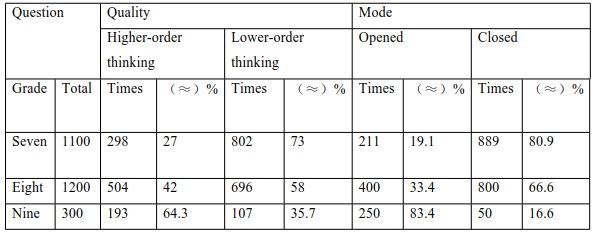
3.3.2Questionnaire
The questionnaire method is a widely used method in the social survey at homeand abroad. A questionnaire is a research device consisting of a series of questionsand other prompts for the purpose of gathering information from respondents. And theresearcher measures the problem with such a controlled measurement to gatherreliable information.
In order to understand the situation of junior middle school students in Englishclassroom questioning, the author divides those questions into 7 divisions accordingto the common types of questions..
Table 2 Seven divisions of questionnaire
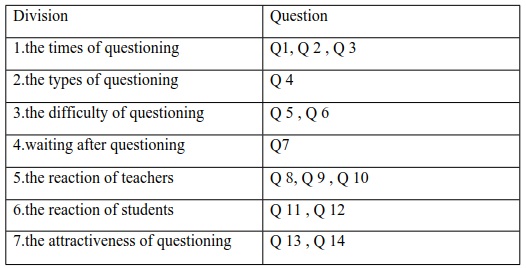
In order to ensure the quality of the survey, before it was printed, 18 studentswere selected to conduct a small scale test. Then the questionnaire was carefullydiscussed. Finally the questionnaire was finalized after being revised again. In orderto remove the concerns of the respondents and improve the reliability of the survey,the paper asked the students to write the questionnaire anonymously. In addition, inorder to make the respondents understand the investigation clearly and reduce waste,the teacher was asked to explain the items of questionnaire when giving out thequestionnaires.
3.3.3Interviews
An interview is a kind of research in form of conversation where questions areasked and answers are given. In common parlance, the word "interview" refers to aone-on-one conversation with one person acting in the role of the interviewer and theother in the role of the interviewee. It is necessary to learn about different types ofmaterials from different types of people when studying more complex problems. Bythe arranging and inducing of interview recording, the paper draws the followingconclusions.
Table 3 Two of the interview questions

From table 3, Q1, all teachers said that their students prefer English to othersubjects. Three teacher said that her students enjoyed the relax atmosphere in her class.
One teachers thought that English was the main subject for junior middle schoolstudents, because it was the same as that of Chinese and mathematics in senior highschool entrance examination. There was a teacher who thought that English was ofgreat importance in the international community, especially, in Changshu, acomparatively developed city. So it is also necessary to learn English well. Therefore,teachers should continue to strengthen theoretical learning, improve their own qualityfor the sake of better teaching results.
Question 2: what factors do you usually take into account when designingquestions during the course preparation?
As to which factors will be considered in designing classroom questions, fourteachers thought that the questions should be designed according to the new EnglishCurriculum Standard. Because in the junior middle school stage, the main purpose oflearning English is to prepare to meet the standard. Another teacher thought the mostimportant thing in designing question was required to consider the student'scomprehensive ability, if the question is too difficult for the student to answer, it willnot achieve the proposed effect; the other teacher believes that interest should betaken into account when designing questions, that is, by asking interesting questions,students can learn English in a positive way. In view of this, during the middle school,the teacher's teaching purpose is very clear. Therefore teachers are similar to designquestioning.
Question 3: how do you motivate students to answer questions in class?
In response to this question, five respondents mentioned the design of group work,because it can make students answer the questions quickly and accurately throughgroup discussions. Four more mentioned role-playing. It shows that role-playing isalso a common method used by teachers in English class, and students are veryinterested in that. In addition, there are also peer discussions, which are commonactivities. Practice has proved that these activities have achieved someaccomplishments. For example, students' ability of expression have been improved.
The paper suggests that under the condition that the students cannot solve the problemwell through group cooperation so the teacher should use the Socrates methodmentioned in the previous part to assist the students and apply the teaching method toreal world.
From table 3, Q 2, there are four teachers heard Maieutic of Socrates, but onlytwo teachers knew the substance. As to asked when and how to use Maieutic ofSocrates, several teachers said almost did not use. Problems have cropped up. Fromthe level of teachers significantly improved a lot, they all knew a lot of theoreticalknowledge, but they cannot combine the theoretical knowledge with the actualteaching well.
Question 5: what is your respone when your students fail to answer questions ormake mistakes?
The five teachers were interested in the question and put forward their ownmeasures one after another. In conclusion, they could be classified into five points.
First, asking the classmates in same group to give a helping hand and then letsomeone who had a mistake to retell. Second, the teacher gave a clear hint. Let thestudent follow the teacher's hint and find out the correct answer. Third, the teacherwaited for the student until he came up with the answer. Fourth, the teacher askedagain in a different way. Last, teacher neglected the error for the time being thenindicted students in the following revision.
3.4 Data collection
After collecting the questionnaires, the paper has done the validity screening tothe questionnaire. First, owing to the amount of missing values is less than 20% of thetotal, the missing values that occurred when no data value was stored for the variablein an observation were processed: listwise deletion was taken; the statistical data isbased on the valid value. The first three questions of the questionnaire are the testquestions of credibility of this questionnaire. In the design of the questions, thequestionnaire was designed the same question in three different ways. The purposewas to test whether the respondents had perfunctory psychology or not. If the firstthree questions given by the object are identical (except for option C) then thequestionnaire of the object can be regarded as an invalid paper. For descriptivestatistical processing, finally, a total of 160 effective questionnaires are obtained, andthe effective rate of the questionnaire was 88.8%. The following data are based on the160 valid questionnaires.
Chapter Four Analysis and Strategies ofClassroom Questioning
4.1 Analysis of classroom questioning
After deliberate analysis, it could be found that there are some palpable problemsin the types of questioning, the reaction of students and teachers and waiting afterquestioning. Therefore, the author focus on the three problems in this paper.
4.1.1 The types of questioning
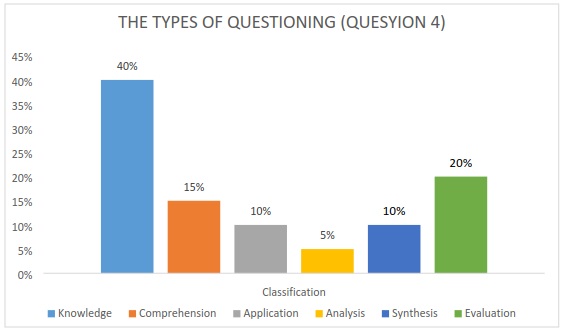
Figure 1
Asking questions is important for learning in English, but it does not mean thatthe more questions, the better effect. Questions should be designed in a wise andpurposeful way, contributing to the all objectives of the lesson, stimulating thedevelopment of thinking and knowledge, as well as helping to maintain effectiveinteraction between teachers and students. According to Bloom, the types of questionscan be divided into six types. There are knowledge, comprehension, application,analysis, synthesis and evaluation. From figure 1, it is easy to find that most teachersprefer knowledge questions to other types of questions. Because knowledge questionsare the fundamental knowledge we have learned in class, it is necessary and easy forstudents to master. Nevertheless, other types of questions are of equal importance.
Comprehension questions can help students to understand of facts and ideas bycomparing, organizing, translating, describing, interpreting, and stating the main ideas.
Application questions can help students to apply acquired knowledge, techniques,facts and rules in a different context. Analysis questions can help students to identifyrelationships, motives and evidence to support main viewpoints. Synthesis questionscan help students to combining elements in a different approach and proposingalternative solutions. Evaluation questions can help students to present opinions bymaking an informed standpoint about information based on a set of criteria. In class,teachers ignore the importance of cultivating students' thinking more often than not,so the questions they asked tend to singleness.
In addition, based on right two columns of the Table 1, it can be found that mostof the questions teachers asked are closed questions which means the answers werealready known to the teacher and a great number of them were easy "Yes", or "No","Right", or "Wrong", "True" or "False" among which very few were genuinequestions. Most teachers did not seriously think about what questions they need to askand what questions they should ask in their classroom questioning and how to askquestions, in which case they often asked questions in a mechanical or monotonic way.
According to the middle two columns of the Table 1, in most English class, the ratioof lower-order thinking was higher than higher –order questions. Some teacher arguedthat it was hard to ask higher –order questions because they thought that students’
language level was too low to answer higher –order questions. It didn't inspirestudents' interest in learning, even if some students answer questions correctly. Theyare highly motivated, but these questioning neither transfer students’ knowledge norreinforce students’ knowledge properly.
Last but not least, the monotonicity of the teacher's way in questioning wasincapable of attract the interesting of students, not to mention develop the ability ofstudents' thinking. It made some students feel dull and boring. For instance, in orderto save time, some teachers only asked the top students or only allowed students toanswer questions together and so on.
4.1.2 The performance of students in answering questions
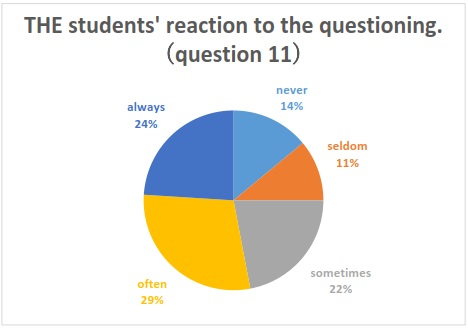
Figure 2
Figure 2 showed the current situation of students’ reaction to the questioning.
Nearly one fourth of students thought they always put up their hands; only 29%students thought they always raised their hands; it meant just about half of thestudents were inclined to answer questions on their own initiative. It was unusuallycircumstances in middle school at least and teachers need to analysis why somestudents disliked putting up their hand. Was it because the question is too difficult forthem? Or was it because students' enthusiasm for learning is poor? Now moving sightto figure 3, it showed that 42% of the students said they had a desire to ask questions,but dared to ask. 25% of the students wanted to ask but hadn’t a chance. Only 20%students asked questions to the teachers. Thus, there is a lack of communicationbetween teachers and students.
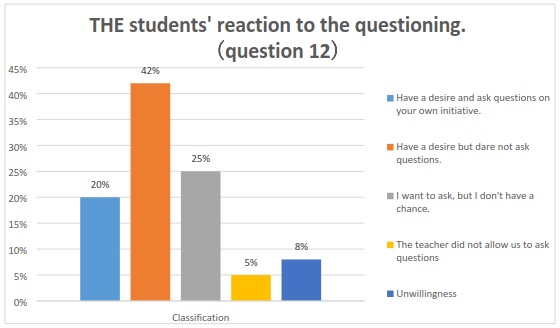
Figure 3
The author observed 14 English teachers from different junior middle schools andfound some problems in classroom questioning, such as the different reactionsbetween teachers and students before and after questioning.

Picture 1
Picture 1 came from a grammar lesson in grade eight, the key point of the lesson
was the usage of "if" and "unless" in adverbial clause of concession. At first, studentsknew the surface meaning of "if" and "unless", but didn't know the difference. Next,the teacher gave students four sentences which need to be filled in the blanks (Picture1) within three minutes. Time was up, some students were mentioned to fill in theblanks, but they all stopped at the second sentence. The teacher seemeddisappointed at the behavior of students in the open lesson. At last, in order to savetime, the teacher answered the question by herself. It is obvious that the teacher onlyasked questions blindly and lack of enlightenment.
Another example, after the English teacher who came from Grade sevenpresented the sentence, "He d swimming, so he seldom goes swimming." thereare the dialogue between the teacher and her students in grade seven.
T: Which word can be filled in the blank?
S1: He doesn’t like swimming, so he seldom goes swimming.
T: Not very good.
S2: He like swimming, so he seldom goes swimming.
T: No.
S3: He enjoys swimming, so he seldom goes swimming.
T: Anyone else?
S: … (Silence)
Later, the teacher waited for another minute, but no student dared answer. Theteacher shook her head disappointedly, finally she said the answer herself, and askedthe students to copy the sentence. As homework, the sentence should be copied in thenotebook five times.
4.1.3 Teachers' feedback
Feedback occurs when outputs of a system are routed back as part of a chain ofcause-and-effect that forms a loop or circuit. In classroom, feedback can be dividedinto speech feedback and body language feedback. In the process of the questioning,Students are all eager to get praise from the teacher. As a matter of fact, there are stillmany problems during the teacher's feedback in the real class.
Some teachers in the classroom lack timely and effective feedback during thestudents' learning process and results caused by classroom questioning. One is thatthere is no feedback. No matter whether the answer is good or bad, the teacher don’tmake any timely feedback. The second is understatement, no affirmation, no negation,or even a simple repetition. The reasons are as follows.
Firstly, some teachers do not give any feedback because of lack of experience,lack of ability to adapt the classroom, and confusion when problems rise up. Secondly,in order to complete the teaching task, some teachers forgot to give any feedback.
Last but not least, teachers praise students' answers with such feedback. Manyteachers often use "Good", "Very good", "Excellent", "You did a good job" and so on.
Such feedback is exaggerated, false, and coping.
4.2 Strategies of classroom questioning
4.2.1 Diversified design of questioning
Teachers should pay attention to the diversity design of classroom questioningand improve the effectiveness of classroom questioning in the classroom. For that,teachers can take flexible and diverse forms to enable students to be active in all kindsof questions. Promoting classroom teaching, such as questions and topics that are veryclose to the students' daily life, not only help to attract students' attention and curiosity,but also help teachers control the classroom. Teachers should activate the classroomatmosphere and control the students' thinking. In order to enrich the content ofclassroom teaching, it is necessary to flexibly use various ways of asking questions,such as group work, pair work, whole work, individual work and so on. Therefore,teachers do not have to stick to a certain form, but can be used flexibly according tothe specific content. The ability of students to accept new things is strong, so teacherscan change the way of asking questions in the past, combining the languagebackground, establishing the real context, and let the students connect with the realityand carry out the real language communication.
In order to improve the ability of students to analyze and solve problems, teacherscan put forward some enlightening questions. Students are encouraged to breakthrough the limitations of English thinking patterns, recombining existing knowledgeand experience, and seeking new answers. Teachers also should pay attention to thedevelopment of students' minds when they design English questions. In order toensure the effectiveness of classroom questioning, teachers should focus on Englishteaching materials. In order to synthesize the various aspects of knowledge thatstudents have learned, the best solutions can be designed to provide students with theopportunity to exercise their thinking level. Teachers should not only rearrange andcombine the knowledge in the textbook after reading the textbook carefully, but alsodesign the questions which are related to the actual cognitive level of junior middleschool students.
4.2.2 Appropriate guidance and encouragement
After students were asked a question, most students are afraid to make mistakesso they are very cautious, some even dare not answer. Students should be encouragedto stand up and say what they are thinking. Teacher can say "It’s nearly right", "Takeit easy", "Try again, I’m sure you can do it better". When the student is confusedabout the question, the teacher should give hint and direction of thinking. When thestudent is arguing about the question, it is necessary to catch the focus of thecontradiction and enlighten students. When teachers ask questions of continuity, theycan use the Maieutic of Socrates to link up with each other step by step and raisequestions in accordance with the circumstances, finally approaching the conclusiontogether. If the student answers the easy question correctly, you can say "Yes","Right", "Good", "Well done", "Excellent" or "Wonderful".
In view of the above dialogue between teachers and students in grade seven,teacher can use the Maieutic of Socrates to guide and encourage students to answerthe question
T: Which word can be filled in the blank?
S1: He doesn’t like swimming, so he seldom goes swimming.
T: Very good, but can you use one word to fill in the blank?
S1: He likes swimming, so he seldom goes swimming.
T: If he likes swimming, why he seldom goes swimming?
S1: Seldom means not often, so he doesn’t like swimming.
T: Yes, so we should use the opposite word of the word’ like’
S1: Oh. I know, we should use the word ’dislike’. He dislikes swimming, so heseldom goes swimming.
T: Wow! So smart you are. Let’s clap for him.
S: (Clapping)
The process of students' learning is a essential cognitive process. Teachers' properquestioning can not only arouse students' strong desire for knowledge, but alsopromote the consolidation of their knowledge. It depends on whether the teacher leadsthe inspiration. Therefore, the teacher can ask some questions which are veryenlightening and instructive, and the answers are not easily available. Teachers mustbe obtained through students own exploration and hard work. Only through studentsown exploration and effort can they obtain it, so that students feel that the problem isfamiliar but can’t be solved immediately. Maieutic of Socrates can cultivate students'breakthrough thinking framework from creating contradictions. However, teachersmust pay attention to the fact that this process is a process of information exchangebetween teachers and students when they use this method, and this method is notruled out if in the course of exchange, some things that teachers did not think of inpreparing lessons should occur.
Finally, in classroom questioning, teachers should also pay attention to observingstudents. For example, if most students have difficulties after some questions havebeen asked, teachers should realize that the questioning may be too complicated. Inthis case, teachers should slow down their speech or decompose the questioningmoderately. Giving students timely help and guidance can save their self-esteem andenable them to maintain a good learning mood in the classroom, so that students canconfidently and successfully in answering questioning.
4.2.3 Timely and effective feedback
Cheap, inappropriate or excessive praise makes it easy to produce complacencyand mental inertia which can't inspire students to thinking deep and positive languageoutput. Teachers' feedback should not only include feeling such as sighs, praises, orcomments, but also include inspiration. Feedback as the ending of one communicationand the beginning of another communication should be interacted with the next topicat the same time. Teachers can adopt the first step of Maieutic of Socrates, with thehelp of Sarcasm (such as questioning) to constantly trigger students. New languageoutput promotes classroom interaction.
T: OK, everybody. National Day is coming. What are you going to do during theholidays?
S: I’m going to Hangzhou.
T: Is that so? What places would you like to visit in Hangzhou?
S: I plan to visit the West Lake. I'm going to walk around the lake and enjoy thebeauty of the old park.
The teacher said, "What places would you like to visit in Hangzhou?" Leadingstudents to talk about National Day Holidays to Beijing and giving students moreopportunities to express themselves after questioning. Superficial feedback cantemporarily stimulate students' interest, but cannot last for a long time. Teachers couldbuild scaffolds and platforms for students from the perspective of students, the depthof thinking and the level of communication. With the guidance of teachers, studentsshould constantly think and innovate to express their thoughts and feelings and thesense of success in doing things in English. Finally, students will get initiative andenthusiasm in learning languageIn order to create the diversity of feedback language, firstly teachers should payattention to take evaluation, repetition, help, speculation, explanation, induction,questioning, adjustment and other different feedback ways to increase students'
language input and language output. Moreover, Teachers should pay attention tostudents' psychological feelings and emotional needs. In addition, teachers also shouldpay attention to the timeliness of feedback. Timely feedback allows students tocorrect mistakes and praise students who answer correctly.
Chapter Five Conclusion
After probing into the definition and theoretical basis of Maieutic of Socrates andanalyzing specific cases of the application of Maieutic of Socrates in classroomquestioning in junior middle school, the author summarizes the major findingsaccording to classroom observation, teacher interview and questionnaire. From theresearch, it can be found that the existing problems in English classroom questioningsuch as the single of question design, the deficiency of proper guidance andencouragement and the lack of effective and timely feedback in the process of askingquestions. In the light of the Maieutic of Socrates the paper puts forward a newstrategy to promote the efficiency of classroom questioning. Above all, appropriatemethod which includes the design questioning from multiple angles and levels shouldbe adopted for teachers to control classroom. Moreover, appropriate guidance andencouragement is an effective prescription to incentive the interesting of students.
Finally, timely and effective feedback is a cool practice to optimize teaching andimprove the ability of students in analyzing and solving problems. The paper hopesthe research could help readers grasp the classroom questioning skills better in thecontext of the new curriculum reform and make better use of the Maieutic of Socratesto design and teach questions in order to improve the English classroom level ofjunior middle school students.
Admittedly, there are still some shortcomings in this report. First, the surveybased on a small sample size, and it may have limited generalizability. Moreover, it isthe first time for the author to study classroom questioning, so the author doesn’t havemuch experience in this kind of work. However, the author still hopes this report canbring some reflection and inspiration for English teacher in middle school classroomquestioning.
REFERENCES
[1] Thompson G, Training teachers to ask questions[J]. ELT Journal. 1997
[2] White J & Lightbown P M,. Asking and answering in ESL classes[J]. Canadian Modern Language Review. 1984
[3] Penny, Ur. A Course in Language Teaching: Practice and Theory [M].England: Cambridge University Press.1996: 227-229.
[4] Wu Kam-yin. Classroom interaction and teacher questions revisited[J]. RELC Journal. 1993
[5] Dantonio, M.& Paul C.B.2006, 《课堂提问的艺术》[M]。宋玲译,北京: 中国轻工业出版社
[6] 张树贤,浅谈新课程背景下初中英语有效课堂教学《时代教育:教育教学版》 [M], 2011 (1) :189-189
[7] 陈周,韩健飞,浅谈新课标下学生问题意识的培养[J].才智. 2008(16)
[8] 周婷,余梦,苏格拉底的“产婆术”带给教学的启示[J].中国校外教育. 2009(S2)
[9] 辜筠芳,新课程背景下的课堂对话方式转型--兼议苏格拉底的“助产术”[J]. 上海教育科研. 2009(03)
[10] 高旖旎,新课改下对英语课堂教学实效性的思索[J]. 新课程(上). 2011(07)
[11] 翟莉群,浅谈初中英语教师课堂反馈话语探究[J]. 课程教育研究. 2016(34)
[12] 徐立群,有效提问:促进课堂动态生成的艺术[J]. 现代教育科学. 2012(02)
[13] 陈羚,国内外有关教师课堂提问的研究综述[J]. 基础教育研究. 2006(09)
[14] 李航,杜尚荣,李森,论外语课堂中教师话语的问题及对策[J].教育科学. 2012(02)
[15] 康艳,程晓堂,外语教师课堂话语功能新框架[J]. 外语教学理论与实践.2011(03)
[16] 王蔷,英语教学法教程 [M]. 北京:高等教育出版社. 2006:83-84
[17] 王守仁,何峰,义务教育教科书《初中英语》 [M]. 南京:译林出版社. 2014





